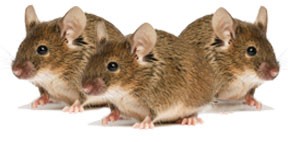Animal Models
Biobanks seek to reduce the hidden variables in animal resources that can affect experimental results.
The use of identical animal resources across research studies is paramount to reproducibility. Dedicated repositories such as the Mutant Mouse Resource and Research Centers (MMRRCs) and the Rat Resource and Research Center (RRRC) provide researchers with consistent animal resources while also allowing them to sidestep the burden of raising lab animals.
With funding from ORIP, these biobanks develop, store, maintain, and reanimate animal models from germplasm or cell lines with criteria and systems in place to match exact specifications. The resulting, carefully bred animal models make it possible for researchers to isolate previously unrecognized variables that influence human disease.
Working on behalf of the MMRRCs and RRRC, Craig Franklin, DVM., Ph.D., and his colleagues at the University of Missouri Metagenomics Center (Drs. Elizabeth Bryda, Aaron Ericsson, Jim Amos-Landgraf, and Yuksel Agca) study the variation in animal resources that can confound replication studies. “We strive to refine, perfect, and unearth factors in our animal models that were previously unrecognized,” says Dr. Franklin.
Dr. Franklin and his team are currently examining what might account for irreproducible results in cancer studies that featured animal models with identical genetic profiles and a constant environment. Variation in gut microbiota is a promising explanation. “We know the microbial make-up of our intestines influences disease,” notes Dr. Franklin.
In one study investigating the gut microbiota variable, a team of RRRC scientists, working with a rat model of colon cancer, transferred genetically identical embryos into surrogate rats obtained from different sources that harbored different gut microbiota. Their findings confirmed that the gut microbiota of the offspring matched that of the host mother. Furthermore, they found that subtle variations in gut microbiota correlated with different levels of colorectal cancer. Even more exciting is their discovery that an abundance of certain bacterial organisms may suppress tumor development. The work was published recently in Oncotarget.
“Characterizing microbiota is a troubleshooting tool,” explains Dr. Franklin. “We can examine the extent that microbiota influence reproducibility (the ability to repeat results).” To enable further study into this variable, the MMRRC currently offers researchers mice that can be reconstituted with four different microbiota profiles.
Research into variables such as gut microbiota is valuable on two levels. First, it reveals opportunities to refine animal models to greater levels of specificity, helping avoid unintentional variability. Secondly, this line of translational research suggests that altering human gut microbiota may offer preventive or therapeutic approaches to cancer and other diseases in the human population. Toward that end, collaborative rodent studies on inflammatory bowel disease, multiple sclerosis, diabetes, asthma, neonatal immunity, autism, and aging are underway.
Related reading:
Ericsson, A. C., Davis, J. W., Spollen, W., Bivens, N., Givan, S., Hagan, C. E., McIntosh, M., & Franklin, C. L. (2015). Effects of vendor and genetic background on the composition of the fecal microbiota of inbred mice. PloS One 10(2):e0116704. doi:10.1371/journal.pone.0116704.
Lloyd, K, C. Franklin, C., Lutz, C., & Magnuson, T. (2015). Reproducibility: Use mouse biobanks or lose them. Nature 522, 151–153.



